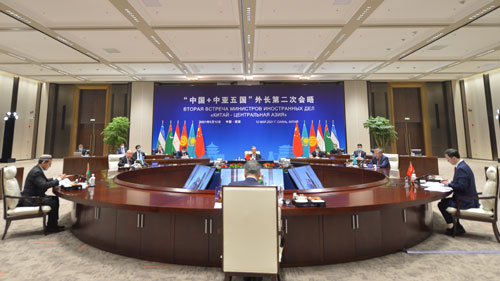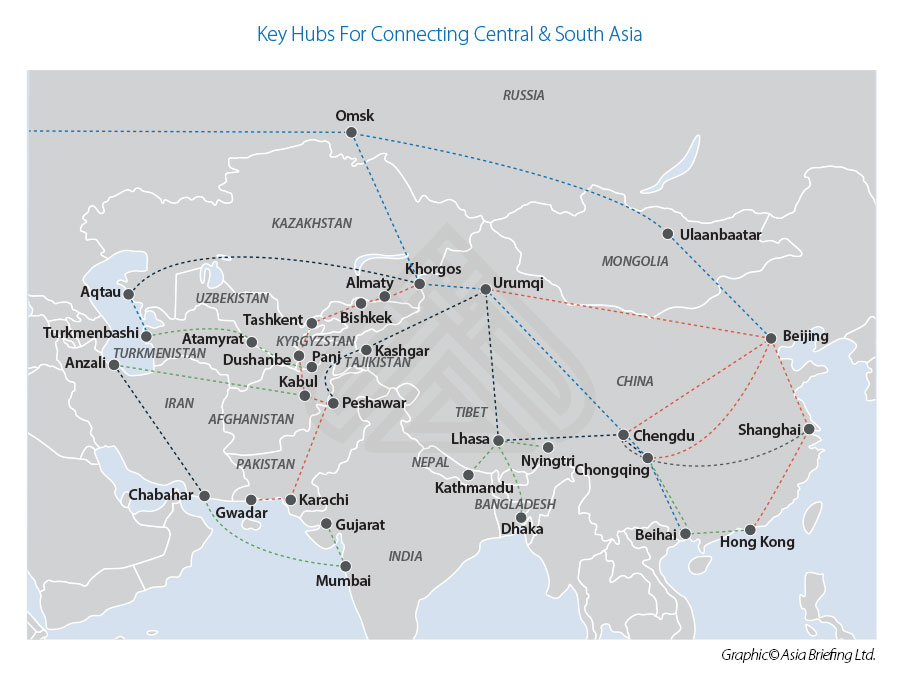The China-Central Asia Conference: Analysis

- C+C5 forum takes shape with numerous regional initiatives
By Chris Devonshire-Ellis
China’s Foreign Minister Wang Yi has called on China and Central Asian countries to explore a new style of regional cooperation and build a community with a shared future between China and Central Asia.
Wang made the remarks at the second China plus Central Asia (C+C5) foreign ministers’ meeting in Xi’an, capital city of northwest China’s Shaanxi Province, and was attended by Kazakh Deputy Prime Minister and Foreign Minister Mukhtar Tleuberdi, Kyrgyz Foreign Minister Ruslan Kazakbaev, Tajik Foreign Minister Sirojiddin Muhriddin, Turkmen Deputy Prime Minister and Foreign Minister Rashid Meredov, and Uzbek Foreign Minister Abdulaziz Kamilov.
Wang also held separate discussions with four of these Ministers, with China’s Foreign Ministry issuing these reports as follows:
Background
Central Asia comprises five states with a combined population of 77.2 million. Economies have considerable potential to develop, with target GDP, based on purchasing power parity (PPP), estimated using World Bank methodology at an aggregate US$900bn, three times today’s nominal value. Uzbekistan has the largest population, with 33.9 million, and Turkmenistan the smallest at 6.1million. The region is resource-rich, with the Caspian states, Kazakhstan and Turkmenistan holding huge under-developed reserves of natural gas and oil, and the mountainous Kyrgyzstan and Tajikistan home to a wide range of mineral resources and hydro-electric power. Land-locked Uzbekistan has huge agriculture and renewable energy potential.
On a collective basis, the ‘China-Central Asia’ (C+C5) group held the following discussions, with subject summaries and analysis below:

Covid-19 Assistance
Wang said China is willing to work with relevant parties to continuously improve the epidemic prevention and control mechanism and conduct telemedicine cooperation to improve public health capacity. A new round of vaccine aid and assistance in enhancing the R&D and production of COVID-19 vaccines will also be made available to the group, Wang added.
Agriculture & Hi Tech
He also called on China and Central Asia to enhance cooperation in modern agriculture and build a comprehensive agricultural science and technology demonstration park. Central Asia is seen as vital to China’s food security; with the country having 20% of the global population but just 5% of global arable land, while areas of Central Asia, most notably Kazakhstan and Uzbekistan are considered regional bread baskets. Increasing yields and developing new, genetically modified strains of wheat and rice as global warming threatens crops will be a key area.
He said China is willing to deepen and strengthen cooperation in climate change and biodiversity conservation and to share its experience in poverty alleviation with these countries.
Wang stressed the sharing of advanced technology and equipment to help countries in the region push forward the industrial modernization process and cooperation in high-tech fields, including 5G and AI.
Asia-Europe Transit Routes
“We should make full use of the geographical advantage to ensure the smooth running of China-Europe freight trains and the China-Kyrgyzstan-Uzbekistan railway, and speed up the construction of transnational railways,” Wang noted.
There are several transnational routes planned, including the Trans-Afghan railway, which would link Uzbekistan and neighboring countries with the Middle East and South Asia through ports in Pakistan, as well as joining routes through the Ferghana Valley, linking China overland to Central Asia and potentially also through to Iran and Turkey.
He also called for the establishment of a green channel for goods to guarantee the safety and stability of the regional industrial and supply chains.
Institutional Developments
The Chinese foreign minister told his counterparts that they should work together to form a stable anchor for the region.
Bilateral and multilateral platforms such as the Shanghai Cooperation Organization and the Conference on Interaction and Confidence-Building Measures in Asia should be relied on to resolutely combat the terrorism and extremism, Wang urged.
He also voiced the necessity of carrying out cooperation in the prevention of transnational organized crime, drug control, cyber security, NGO management, and security of large-scale events and projects.
“We must firmly support each other in safeguarding national sovereignty and external security, clearly oppose foreign interference, and maintain regional security and stability,” Wang added.

Afghanistan
As we suggested would occur, Wang also discussed China’s position as concerns Afghanistan, which has become a critical position with US and NATO troops set to exit the country by September 11. Wang asked Central Asian countries to play a constructive role in this regard, based on their respective geophysical, political and trade advantages with Kabul. Due to the political uncertainty at present surrounding Afghanistan, the country was not represented at this meeting. However, Wang’s calls for each of the C+C5 nations to co-ordinate an approach to secure the country will eventually lead it to joining the grouping.
Elsewhere, although Russia was also not present at this session, it is recognized that both Moscow and Beijing are working in tandem on an Afghan solution. Wang Yi visited the Middle East nations earlier this year while his Russian counterpart Sergey Lavrov visited Pakistan and India, also key players in resolving Afghanistan’s troubles.
Mutual Development
Wang also urged Central Asian nations to deepen exchanges and mutual learning to jointly draw a new blueprint for high-quality development.
Noting Wednesday’s meeting reflects the strength of China’s relations with Central Asian countries, Wang stressed at the press conference that the six foreign ministers’ gathering sends a clear message of friendship and intention to create a future together.
According to Wang, the meeting reached consensus on a wide range of issues with significant outcomes.
He noted the six countries agreed to strengthen strategic mutual trust, make efforts toward building a community of shared future for China and Central Asia, continue to defeat COVID-19 with solidarity and cooperation, promote the high-quality construction of the Belt and Road Initiative, and jointly establish the C+C5 regional cooperation mechanism.
China’s Commitments
Wang also said China and five Central Asian countries agreed to work together to promote regional security and stability and to safeguard international justice, uphold multilateralism, oppose interference in internal affairs, adding that they will strengthen the building of the regular meeting mechanism of C+C5 foreign ministers.
Wang mentioned the C+C5 had decided upon the establishment of “three research centers” to carry out cooperation in modern agriculture field, archaeological and cultural heritage research, and traditional medicine.
The China-Central Asia Agricultural Cooperation Center
To promote cooperation in modern agriculture and sharing advanced agricultural technologies.
The Silk Road Archaeological Cooperation Research Center
For conducting archaeological and cultural heritage studies, while boosting cultural exchanges and cooperation.
Traditional Medicine Centers
Undertaking research into local medicinal treatments and promoting traditional medical cooperation.
Wang added the meeting also adopted a Memorandum of Understanding to identify key areas of cooperation and develop a common action plan to provide a stronger institutional guarantee for collective cooperation between China and Central Asia. This is to include three ‘plans’ as follows:
One Country, One Workshop
This calls for building one ‘Luban Workshop’ in each country in Central Asia over the next three years and developing professionals in different fields. Lu Ban (c. 507–444 BC) was a Chinese structural engineer, inventor, and carpenter during the Zhou Dynasty, and is revered as the Chinese patron of builders and contractors.
Educational Training
China will provide another 450 scholarships to the Central Asian countries in the coming three years.
Reducing Poverty and Benefiting Farmers
China will provide annual 100-person training class for officials in charge of poverty alleviation in the Central Asian countries in the next three years, in addition to building agricultural science and technology demonstration parks in the five Central Asian countries.
Wang also briefed the press on three joint statements released at the meeting. Referring to the first, he said that all sides called for deepening cooperation on their response to the pandemic, jointly opposing “vaccine nationalism” and “the gap of immunity.” He said the second statement relates to deepening local cooperation and putting in place subnational cooperation mechanisms, while the third concerns working towards peaceful reconciliation in Afghanistan.
Related Reading
- The US Military Is Set to Withdraw from Afghanistan On September 11. What Happens Next?
- The Greater Eurasian Partnership: Connecting Central & South-East Asia
About Us
Silk Road Briefing is written by Dezan Shira & Associates. The firm has 28 offices throughout Asia, and assists foreign investors into the region. For strategic advisory and business intelligence issues please contact the firm at silkroad@dezshira.com or visit www.dezshira.com





